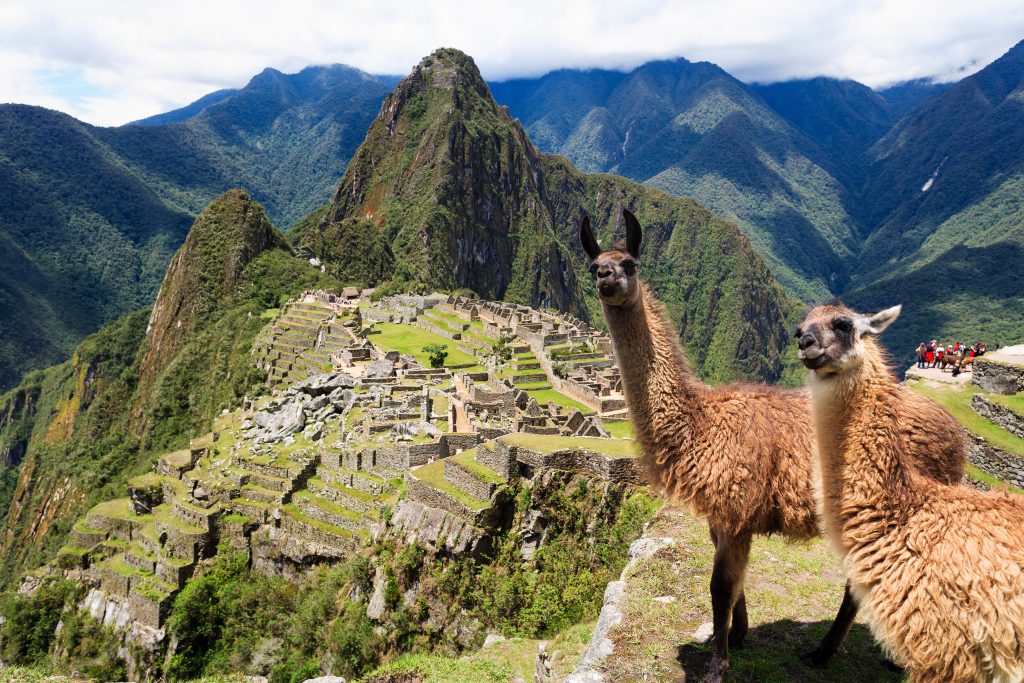
This story was created in partnership with: Peru Tourism Board
Peru is full of magical sights, encounters, gastronomy and culture, in fact it can be hard to know where to start, what not to miss, what there is to see beyond Machu Picchu. We’re highlighting this magical country and giving you the prime tips across the country so you know what to do in Peru, can create your dream itinerary, or decide what tour to book. The adventure is yours!
Lima: the city of kings

Let’s start in the capital, largest city and the best starting point to discover Peru! The city was founded in 1535 as ‘Ciudad de los Reyes’, meaning City of Kings in Spanish, but the name Lima was already in use and quickly became the standard. The area has been habited long before any Spaniards set foot on the Peruvian coast and has plenty of historical sites, from a restored pre-Columbian pyramid (Huaca Huallamarca) to colonial architecture to guide you along the way. Long avenues of colorful houses with decorated balconies and roof terraces with chic bars and restaurants are waiting to welcome you to ‘la noche limeña’ – the Lima nightlife.
Apart from the vibrant, metropolitan vibe, when in Lima, you must, of course, explore the historical treasures at Museo Larco, housed in a beautiful 18th Century building in the Pueblo Libre district. With collections spanning 10,000 years of Peruvian pre-Columbian history, this is the prime place for you to see artifacts of the different styles and cultures in detail that you may not get to see when visiting a historical site. As Peru is packed with fascinating cultures of days past, this is also a chance to get a taste of some places you may not have time to visit in real life, and you can get your tickets beforehand online.
Gastronomical wonders
Peru’s long history and rich biodiversity have given its people opportunities through millennia to grow and refine plenty of plants that originated here or made their way here millennia ago, such as tomatoes, corn, avocado, quinoa, and peppers. This rich heritage has blended with Spanish concepts and, perhaps surprisingly, influences from Chinese and Japanese immigrants that brought cooking techniques, ginger, lime, wasabi, and miso, amongst other things, to the forefront of what today is a world-renowned, unique cuisine, unlike that of Peru’s Latin American neighbors. Lima does not have any Michelin-star listed restaurants (yet), but five of the world’s listed restaurants have earned their star(s) focusing on Peruvian cuisine, a testament to the refinement and unique character many dishes display.
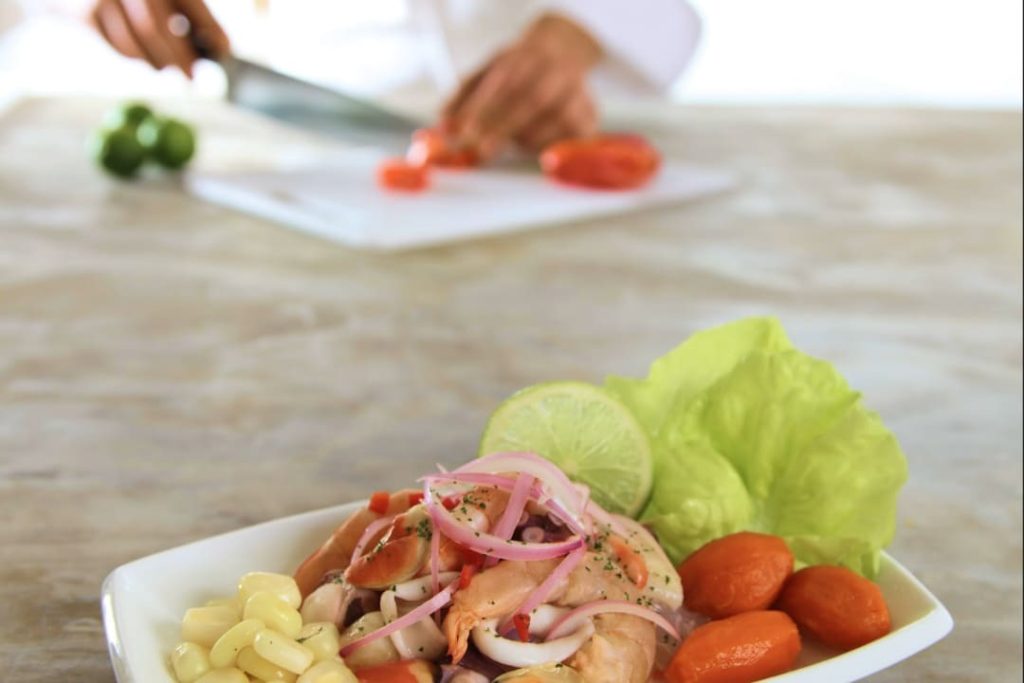
While there are countless delicious dishes to explore, there are a few absolute must-haves when you’re in Peru! Ceviche, for example, is a cold seafood salad that’s made it’s way across the globe as a signature Peruvian culinary invention. Usually prepared with raw fish, but sometimes other seafood or even in vegetarian versions, the ingredients are curated in lime along with chili, onion, usually some toasted corn, and topped with cilantro this is a dish for any time of the day, a mouthwatering journey of textures and lemony flavors.
Seafood often takes the main stage in Lima, as it’s perched on the Pacific coast at an altitude of just 2,87 meters above the sea. This is reflected in another local treat, the celebrated ‘causa limeña,’ a sort of savory layer-cake with a top and bottom of flavor-infused potato that’s been kneaded and with a filling of vegetables and a topping of avocado and tuna, shrimp or chicken. Just like in the ceviche, lime is a crucial part of this dish, marrying the Asian influence with the potato of the highlands in a genuinely Peruvian delight!
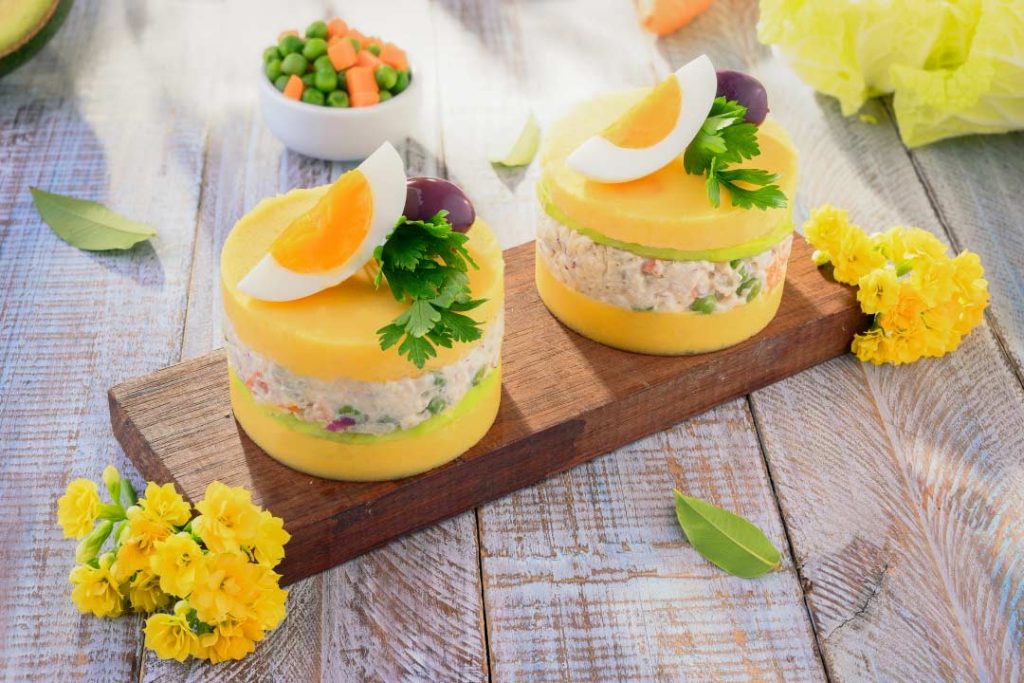
Salud!
Another lemony pleasure is the world-famous pisco sour, with the local grape-based brandy ‘pisco,’ as it’s base its a frothy yet refreshing cocktail invented in the 1920s in Lima. American bartender Victor Vaughen Morris moved to Lima in 1915 with his Peruvian wife and kids, where he opened Morris’ Bar where Peruvian Mario Bruiget, during his apprenticeship at the bar, upped the recipe with Angostura bitters and egg whites, creating the frothy delight as it’s known today. In true Latin American fashion, there’s a sweetener to counteract the citrusy acidity, and the drink is as good at the end of a meal to lighten the palate or substitute a dessert as on its own on one of the country’s countless, welcoming bars.
We don’t blame you if your mouth is watering—start planning your Peruvian adventure already, there are some amazing deals waiting.
Cusco: the Incan capital

Cusco is a city like no other, located high in the Andes and brimming with colonial architecture and vibrant Quechua culture with roots going back to its time as the capital of the Incan Empire. The Lima to Cusco trip can be done by bus or plane but when you arrive, be ready for a unique atmosphere! This is a thriving city where local markets full of colorful produce and crafts thrive, and you can almost forget what year, decade, or even century you are living in. Walking the streets of Cusco will take you from baroque convents, modern yet cozy boutique hotels tucked away in colonial buildings, and world-class restaurants where you can enjoy the flavors of traditional, local cuisine elevated to fine dining. An originally Andean delicacy, nowadays found in many places across Peru, is ‘anticucho’, which is a skewer of well-seasoned meat, typically of cow’s hearts! It’s said to be quite the delicacy, and if you give it a try, who knows, you may just fall in love with the dish.
Machu Picchu: the city in the clouds

Cusco is, of course, known as the starting point for discovering the mystical ruins of Machu Picchu, probably what comes first to mind when we hear the word ‘Peru,’ and no visit here is complete without it! This mythical place is surrounded by the amazing beauty of the Andean plateau, overlooked by the Huayna Picchu mountain top! It was built by the Incas in the 1420s, but as grand and awe-inspiring as it is was abandoned after about a hundred and fifty years as the Spanish conquered the Incan Empire and disrupted their advanced system of communications and administration entirely in a very short amount of time. It wasn’t until 1911 that the city in the clouds was ‘re-discovered’ by American explorer Hiram Bingham although some Westerners had visited shortly before, and clearly some of the local Quechua knew about the city, as it would have been impossible for anyone to ‘stumble’ upon this ‘Wonder of the World’ and Bingham was lead there by local villager Melchor Arteaga. Some 30% of the city has been partially reconstructed, and streets and buildings have been named based on archeological evidence discovered over the years, with still much to be learned!
The Inca Trail
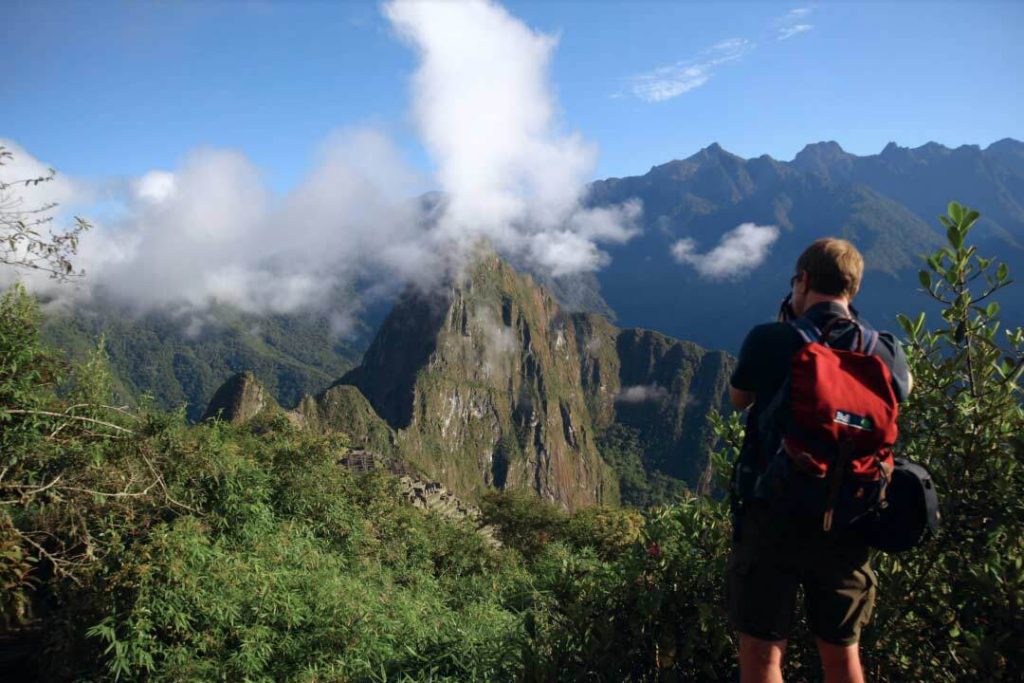
The most famous, iconic, and popular way to reach the ruins is the Inca Trail! It’s actually composed of a combination of trails and can be completed in between 2 and 5 days, depending on the route and intensity of the hike. The classic route is the longer one and goes through several different natural regions such as cloud forest and Andean tundra, and to enjoy the magic of it all, you’ll have to get a permit well in advance as the number of allowed hikers is limited. Furthermore, as the altitude reaches 4,200 meters above sea level on the highest point of the Inca Trail, the temperature can fluctuate wildly from dawn to dusk, so be prepared to dress in layers so you can take something off the day yet have enough to keep you warm at nighttime when the temperature drops drastically. The altitude also requires trekkers to have some level of fitness as it can get demanding, and you’re best off spending at least 24 hours in Cusco or another high-altitude city before taking on the trek, this is crucial to acclimatize to the lower oxygen levels at these wuthering heights!
When you’re ready to book a hiking trip in Peru, this is the place to start looking!
Arequipa

While Cusco has its rich Incan heritage to mesmerize you, this gem further to the south is also a UNESCO World Heritage sight in its own right, with a historical center filled with beautiful Baroque buildings in white lava stone that will take you back in time to the colonial era. Green plazas, ornate cathedrals, and magnificent views of the three volcanoes surrounding the city make this a place not to be missed. Having been the portal to the south for centuries, the city has a strong regional identity manifested in its architecture, local accent, and culinary traditions. A tradition that’s been losing some ground across Peru but is still very much alive in Arequipa is the ‘picanterias’. These are home-style restaurants serving hearty local specialties, traditionally with an open kitchen so you can see what is being prepared and decide what you would like to order. Perhaps a filled rocoto pepper, a somewhat spicy delight filled with meat, cheese, egg, and vegetables baked in the oven… Delicioso!
Lake Titicaca
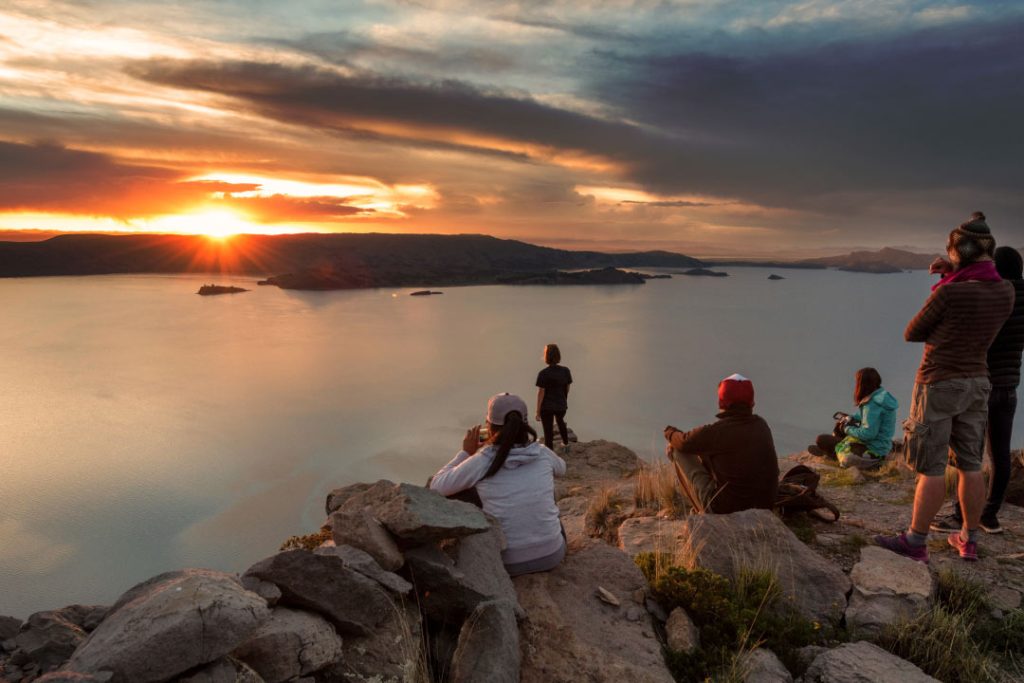
With its location in the south, Arequipa is also the pathway to hiking the southern parts of Peru and discovering the grandiose Lake Titicaca, the highest navigable lake in the world and the largest lake in Latin America! This is the area inhabited by the Aymara people, rather than the Quechua of the highlands, who believed the God of the Sun had been born here. The region shares its local native culture with Bolivia, with the lake being shared between the two countries. On the Peruvian side, Puno is the central hub for discovering the lake and its surroundings and has been important for the locals for many centuries as a trading post where people from the highlands surrounding the city have met to trade and celebrate indigenous festivals.
Floating villages
An unmissable experience at Puno is a visit to the floating, manmade islands of the Uro peoples. The surprisingly sturdy islands are made from the reeds of a kind of grass grown locally called ‘totora’, used to make boats and housing, as well as staple food and tea as the lower half of the reeds are edible. This fascinating lifestyle is older than the Inca Empire that eventually conquered the area, and the Uros have always been the merchants of Lake Titicaca, trading, fishing, and even keeping fowl and cattle on the islands. While their original language has been much supplanted by Spanish and Aymara, and many have moved to the mainland, they have a strong cultural identity, still maintaining and expanding the curious islands.
The adventurous Amazon

The Andes effectively divide Peru from north to south and to the East of the majestic, snowcapped mountains like an entirely different ecological area shared with Colombia and Brazil, we are, of course, talking about the mythical, magical Amazon river! The Peruvian side is easier to reach, safer, and cheaper than the neighboring countries and the departments of Madre de Dios and Loreto make for grand discoveries in the rainforest. Waiting to enchant you with exotic animals in the waters and green tree canopies: lively monkeys, pink dolphins, giant otters, macaws, and toucans with multi-colored feathers and beaks, and even the elusive leopard leaves its traces sometimes.
There’s also fascinating history and culture here, with the native population having traditions and spirituality widely different from the Quechua and Aymara. While not too far from the land of the Incas, these areas were able to maintain their local identity as the Incas were unable to apply their successful conquering tactics from the highlands in the dense jungle. Even the Spanish had difficulties claiming these lands, and while they arrived in 1542 already, it wasn’t until the 1750s that the major city of Iquitos was founded, which is the springboard to many of the Amazon’s discoveries. Here you can find everything from luxury hotels to thatched huts and river taxis. Initially, Jesuit and Franciscan monks and missionaries founded villages and explored communications, but many local tribes still maintain their lifestyle, making for a once-in-a-lifetime visit to one of their villages. Just imagine going to bed with the soothing symphony of the jungle, and the stars above you, no light pollution in sight to dim your view of the constellations in the dark Amazonian sky…
When to go
Peru has two seasons: the dry season, which goes from May to September, and the wet season, from November to March. Trails are more crowded during the dry season, which sees mostly clear skies and warm weather. While Machu Picchu is open year-round, the Inca Trail is closed in February for maintenance and trail recovery, and many tour operators don’t offer tours in the rainy months of February and March. If you’re going to the Amazon, flora and fauna is at their most active during the rainy season, so it’s easier to spot animals, but in the dryer period, more hiking trails are open for discovery due to the lower water levels.
Chances are this article has got you thirsting for mind-blowing hikes and lemony pisco sours. Get going and look into the top Peru deals on TourRadar.


